It’s hard to argue that Hirving Lozano had had a big influence on how PSV played in a few recent seasons. Since his arrival from Pachuca, the Mexican winger had been a consistent performer for the club and made his mark in the process. Occasionally switched between a left-winger and a right-winger in Mark van Bommel’s 4-3-3, he had the license of drifting inside to create chances for himself or stayed out wide and provided the ball for his teammates.
As a consequence, his impressive performances for the Dutch club attracted the eyes of many big clubs. And eventually, Napoli was the name who won the race for his service for the upcoming years. On the other hand, PSV didn’t waste so much time looking for a suitable replacement. A Japanese international who has been at his best in the Eredivisie in the last two seasons is what they needed.
Groningen’s Ritsu Dōan has been decent for the side after he arrived from his native club, Gamba Osaka. He made a total of 66 appearances in the Eredivisie, scoring 16 goals and registered seven assists too. Although he is expected to replace Lozano, it would be quite early to put that pressure on him. Letting him do what he does best in a few months and PSV will have another bright prospect in their hand. This tactical analysis scout report will help you understand how Dōan became a crucial part of Groningen. Meanwhile, using statistics and footages, we will provide an analysis of how he could fit in PSV’s tactics.
Overview
After going through several academies during the early days of his career, he joined Gamba Osaka’s junior team in 2011. Four years later, he became a part of the first-team squad and secured his debuts in the domestic league and the AFC Champions League at the same time. While spending the 2017 season with Gamba Osaka, Groningen came in and asked for him to go on loan.
With 31 appearances and ten goals to his name across all competitions during that season, Groningen were impressed enough to make his move permanent. Since then, he became a first-teamer for the club while keeping his form consistent throughout the season. Dōan is a very versatile player, having played in every position up front during his time with Groningen. Although he prefers to stick to the wide areas, he has been tested in the role of an attacking midfielder recently.
His stats are also worth noticing, as he attempted 7.65 dribbles (45.2% of them were completed), took on 16.22 offensive duels (won 35.4% of them) and registered 0.85 shot assists last season. On average, the Japanese winger made 2.11 progressive runs and 2.82 touches in the box. He is also a player that usually links up with his teammates to build up Groningen’s attacks, making 2.49 long balls (with the accuracy rate of 55.3%) and 3.9 passes to final third (66.9%) per match. Defensively, his active and determined attitude contributes to the team’s defence a lot. With an average of 5.87 defensive duels (won 65.5% of them), 2.35 interceptions and 4.81 recoveries (56.7% of them were inside the opposition’s half) per game, he shows he can be a very useful player when he is not in possession.
Attacking contributions
Last season, Danny Buijs lined his Groningen side up in a 4-4-2 with Dōan playing as a right-winger. Since that position was opposite to his preferred foot (left foot), he tended to cut inside more and leave the wide area for the attacking full-back Deyovaisio Zeefuik below him. It was also the case on the opposite side as Thomas Bruns also shifted centrally more and allowed left-back Tim Handwerker to overlap.
In the first two games of this season, the Dutch manager changed the formation into a 4-2-3-1. He used Dōan as a central attacking midfielder playing right behind Kaj Sierhuis. While occupying the role of a playmaker, he also adopted his dynamic style of play which allowed him to roam more from his position. At times, it seems like he was a second striker who supported Sierhuis and occupied the space that the Ajax loanee created.
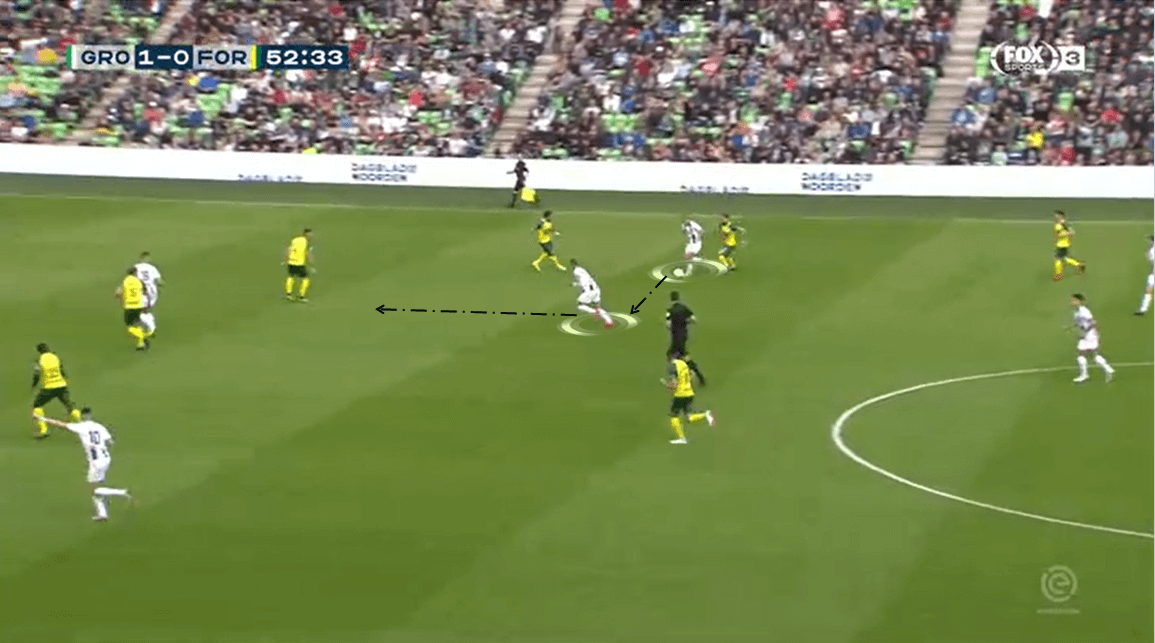
When Dōan is on the ball, he tends to dribble on his own using his pace and technical abilities. With the confident, composed attitude along with a quick mind, he can identify the path that he wants to dribble in. One of his traits that he usually shows during the game is adding a bit of flair into most of his moves. If any defender is blocking his way or attempting to tackle the ball, using nutmeg or just a quick feint will help him bypass the pressure.
Furthermore, defenders find it’s hard to win the ball away from him. One of the reasons that he manages to keep the ball so well is the willingness to shield the ball against the pressure. In the shot below against PEC Zwolle last season, he was receiving a pass from his teammate earlier on and used his body and close control to hold the ball up. Then, came this situation where Zeefuik underlapped to support him but was immediately closed down. Meanwhile, one of Zwolle’s players approached him to try and recover possession. With a quick feint, Dōan got past him and assisted Sierhuis’ goal later on.
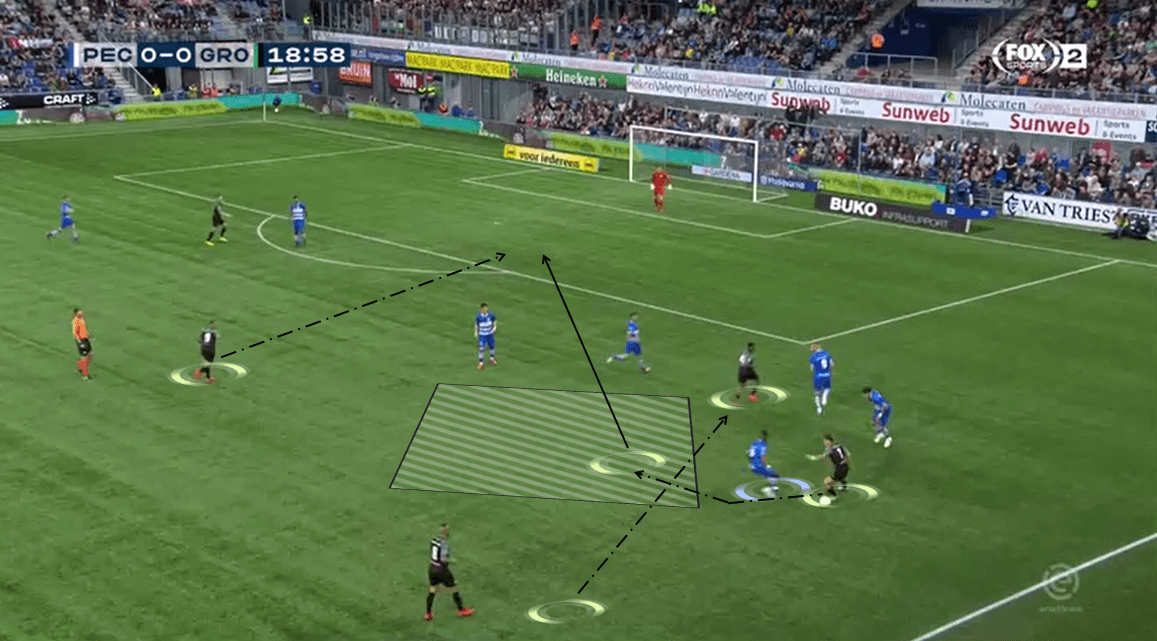
Off the ball, his spatial awareness allows him to capitalise the space that defenders leave behind. During the build-up process, he roams from his position and into free gaps. At the same time, it also turns him into an available passing option. This allows the ball carrier to make progressive passes towards him and start an attack quicker.
Also, against teams who tend to defend narrow and compact, Dōan’s movement helps him utilise the space behind that defensive line. This situation against the Vietnamese national team in the Asian Cup is an example. When the opposition focused on swarming a certain area and marked the ball carrier, Dōan started from a deeper position which allowed him to enter the space next to the line. After he received a pass from Gaku Shibasaki, Bui Tien Dung immediately closed him down but Takumi Minamino offered to pick the ball up to create a chance, which was denied by Dang Van Lam.
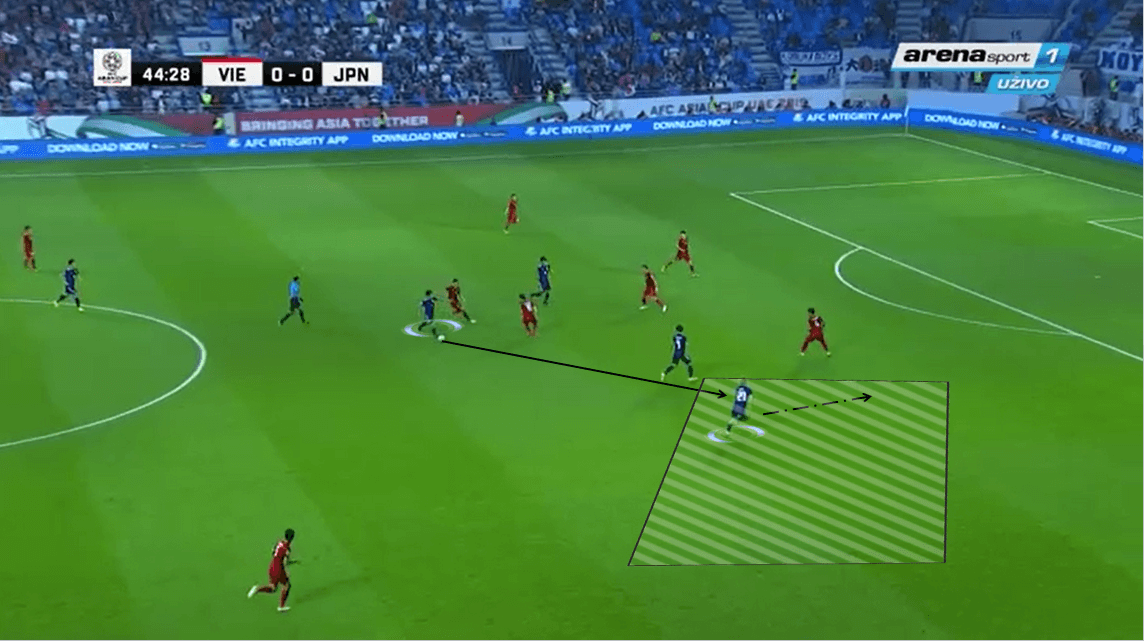
Besides being a threat in open play, he is also dangerous on set-pieces. He can pick out the teammates that are through on goal. Having players who are dangerous in the air such as centre-backs Mike te Wierik and Ko Itakura gives Groningen an advantage in corners or indirect free-kick situations.
On the spot-kick, he remains calm when facing the goalkeeper from the penalty spot. Against Vietnam, he drove his penalty into the bottom right corner. Although Van Lam managed to reach it, the ball went in faster than his reflex and that goal eventually sealed a semi-final spot for Japan.
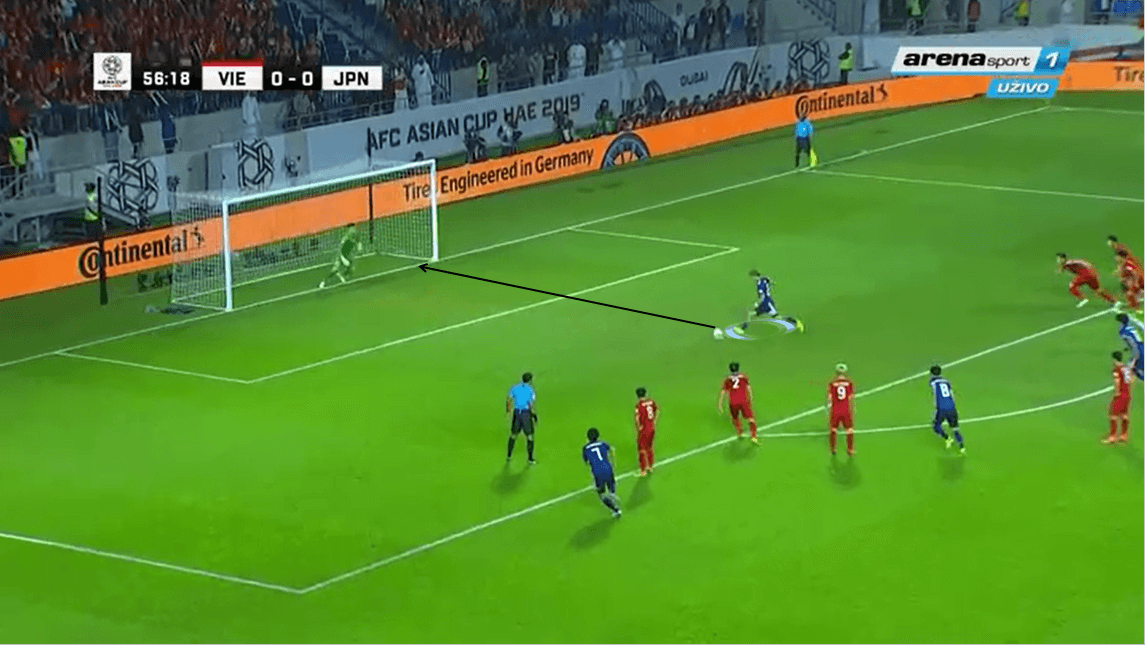
Adapting to the playmaking role
Having played eighteen games as a central attacking midfielder, which included the two matches he started this season, Dōan has become more and more familiar in that position. He tends to pick out teammates who are making runs towards the box with a direct pass. This allows the player to continue his run while still able to receive the ball from the Japanese midfielder.
Sierhuis is a type of striker who usually drops deep to bring his teammates into play, which results in the fact that he has to start his run from a deeper position but it allows the Ajax loanee to understand the situation even more and pick out space where he could run in while waiting for Dōan’s through ball, similar to this situation against Twente.
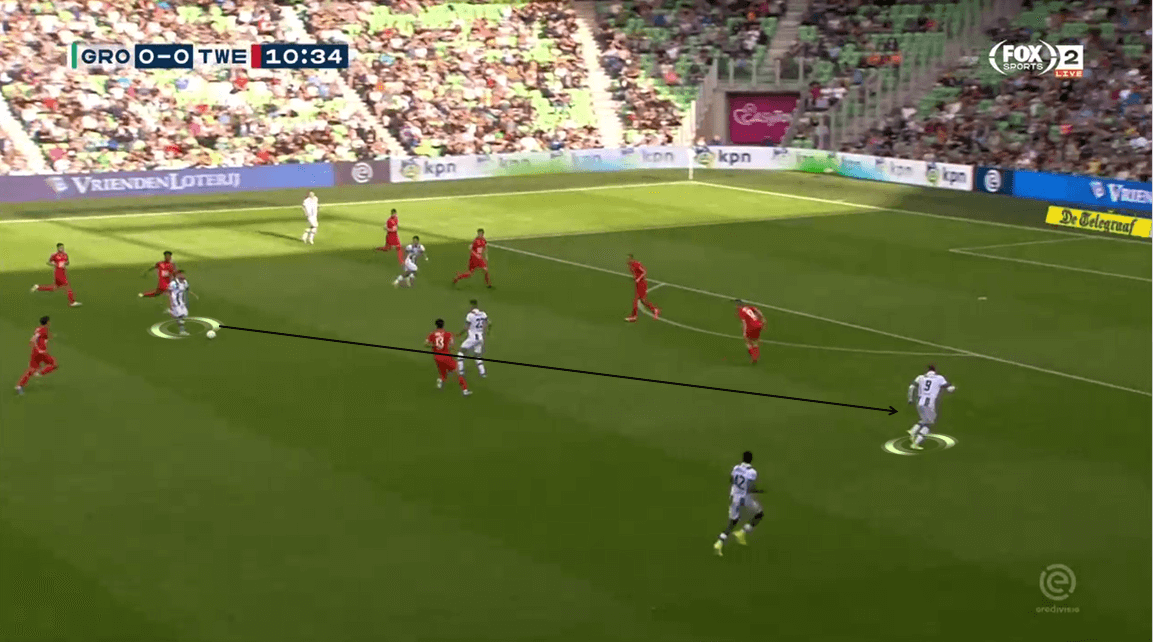
If they are playing against a team who defend deep and organised most of the time, Dōan could even change the attacking direction using a long ball towards the opposite side. This stretches the opposition’s defensive line out and forces them to shift laterally across the pitch to start their press again.
During the time the ball is being switched, Dōan’s teammates could position themselves in free spaces to wait for the attack. Some will even attract the attention of defenders and create spaces behind their backline.
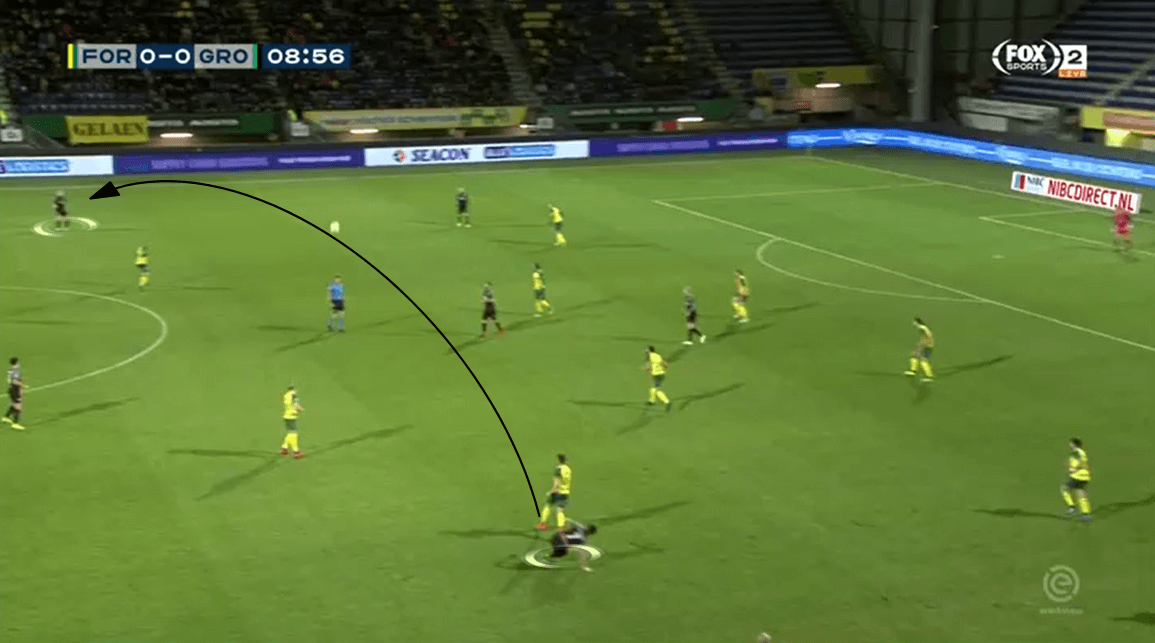
Long balls seem to be the favourite method for the Japanese midfielder to find his teammates. In counter-attacks, Dōan tends to dribble the ball on his own and drag along some of the players. Their attention will be put on him which allows the teammates to make runs behind their backs.
In case one of his colleagues reach the opposite side in an unmarked state, he could make a long pass to him. It keeps the team’s attack away from being disrupted by the opposition and also creates a dangerous chance at the same time.
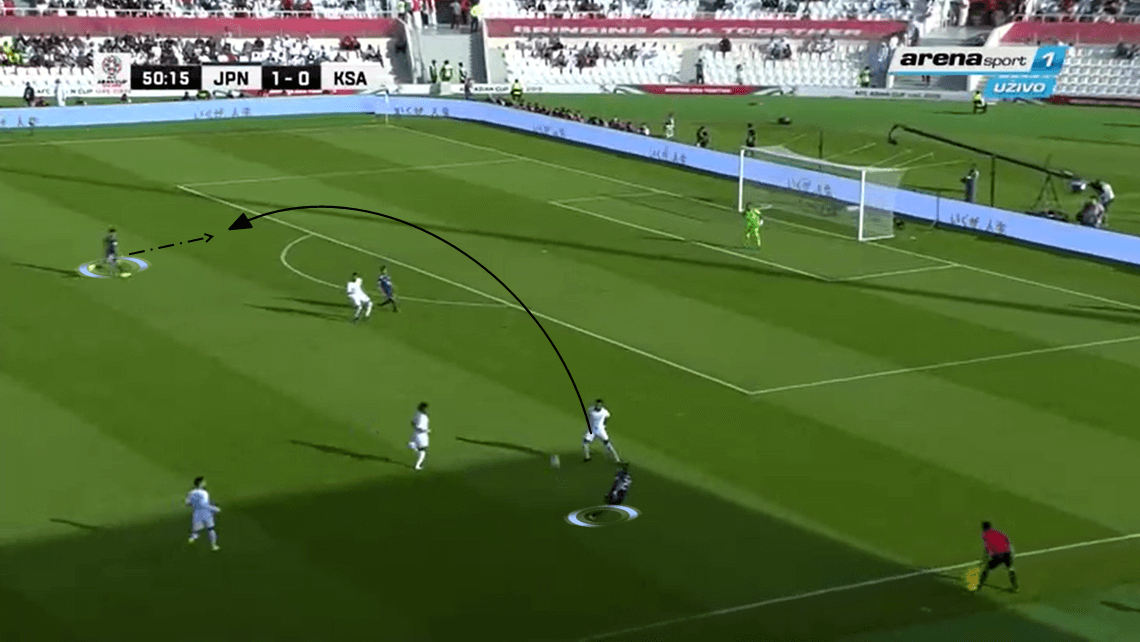
In a closer distance, he would also use lofted through balls into the space behind the opposition’s defensive line. This will benefit strikers who usually sit on the shoulders of defenders and use his pace to beat the backline. This shot below from Groningen’s match against NAC Breda demonstrates the mentioned situation.
When the Japanese player was on the ball, he noticed Mimoun Mahl sat on the shoulder of defenders and attempted to make a breakthrough. Dōan understood what he was intending to do and fed him with an exquisite lofted ball which created a 1v1 against NAC’s goalkeeper.
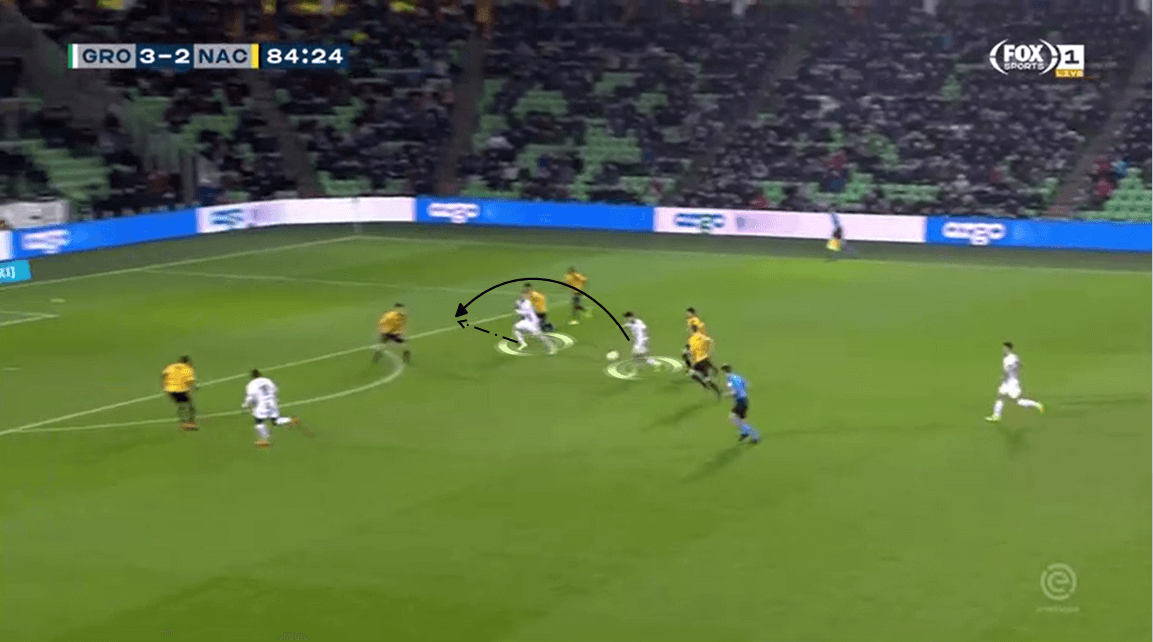
When he is not controlling possession, he is happy to come short and provide a passing option for his teammate. It means that he has to leave his position but there will be another player moving into that spot and occupying it. After Dōan comes short to pick up the ball, he will dribble up the pitch and create an attack.
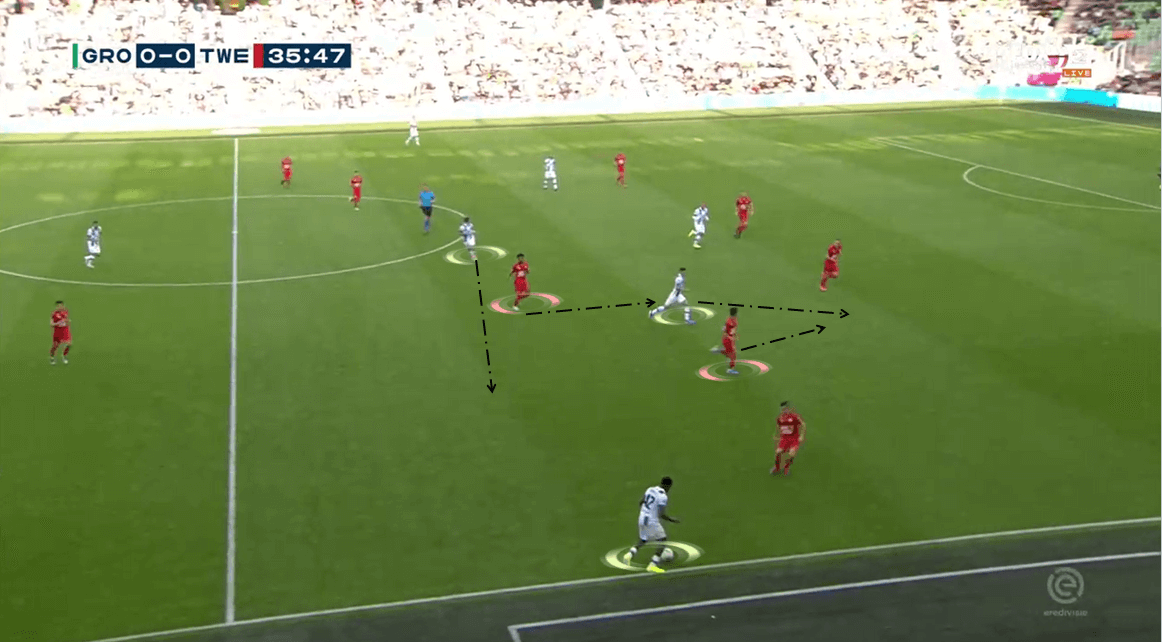
With van Bommel opting to use 4-3-3 and 4-2-3-1 formation most of the time, it is likely that we will see Dōan playing in a more dynamic role. He can occupy the two wider positions in their front three and pairs up with another two pacey players in Steven Bergwijn, Cody Gakpo and Donyell Malen. There could be another scenario as Dōan is being trained into a left-sided or right-sided central midfielder. Playing in the role of a mezzala, he can drift into the half-spaces while still creating spaces for the wing-backs to overlap.
Meanwhile, in the 4-2-3-1 formation, the Japanese can be used as a central attacking midfielder in the same way that he had played at Groningen. While still pairing up with Malen, he can also provide supports for target man Kostas Mitroglou. If the former Dutch midfielder chooses to use the formation that helped them qualify for the Champions League group stage, it will be interesting to see a pacey front line of PSV.
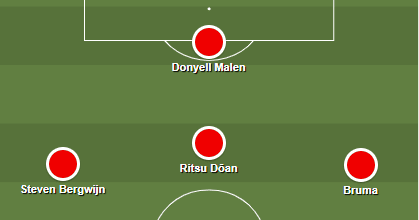
Involve in the team’s pressing
When the team is out of possession, the team press high up the pitch with a 4-4-2 shape. Specifically, with Dōan, he usually marks the nearest centre-back to him and attempts to disrupt their build-up. Along with Sierhuis, they create the first pressing line which will close down two central defenders.
But only when that player receives the ball from his teammate, it will be the trigger for Dōan to start the press. He uses his pace to close down the ball carrier and suffocates the space around him. On the opposite side, this leaves a problem for the Japanese international. As he decides to stick with Sierhuis, he creates a big distance between him and the nearest defender. This requires him to sprint as fast as possible to get to the player, but then he might have laid the ball to one of his teammates.
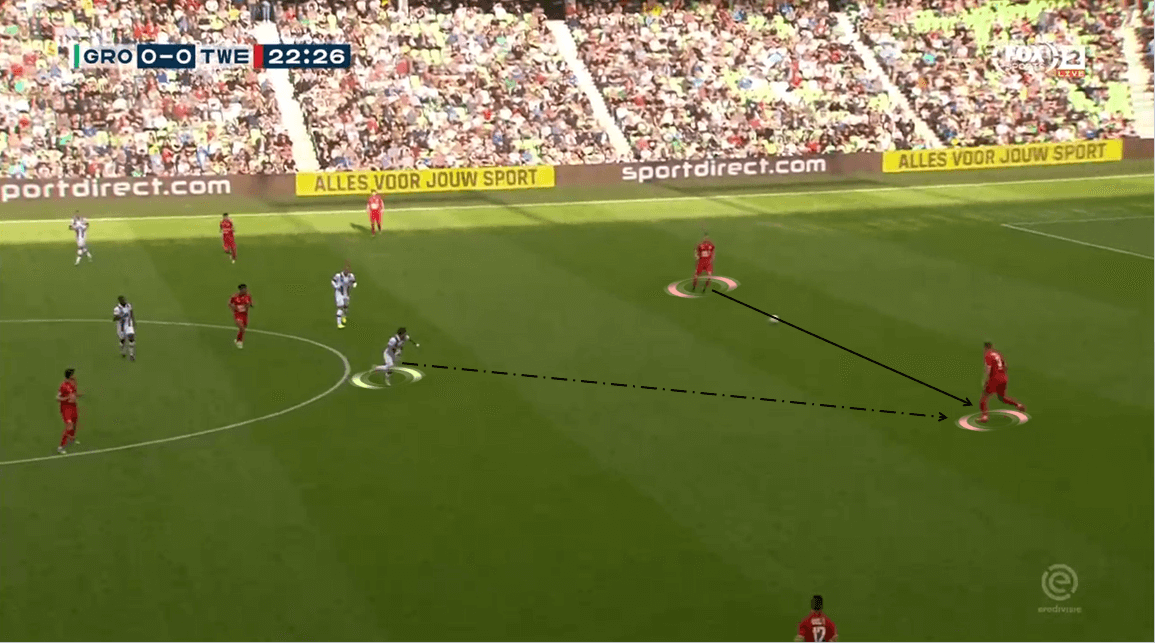
When Dōan does manage to reach the ball carrier, he would capitalise on the ball carrier’s heavy touch to recover possession. Although he usually starts from a deeper position, pace helps him to close the ball carrier down before the player has the chance to execute his next move.
He also shows a remarkable determination to help his team win the ball back as soon as possible. Rather than being comfortable in his attacking position, he immediately joins his teammates in retreating into their half. At the same time, if he is around the ball carrier than he will press him, creating more time for the regrouping process.
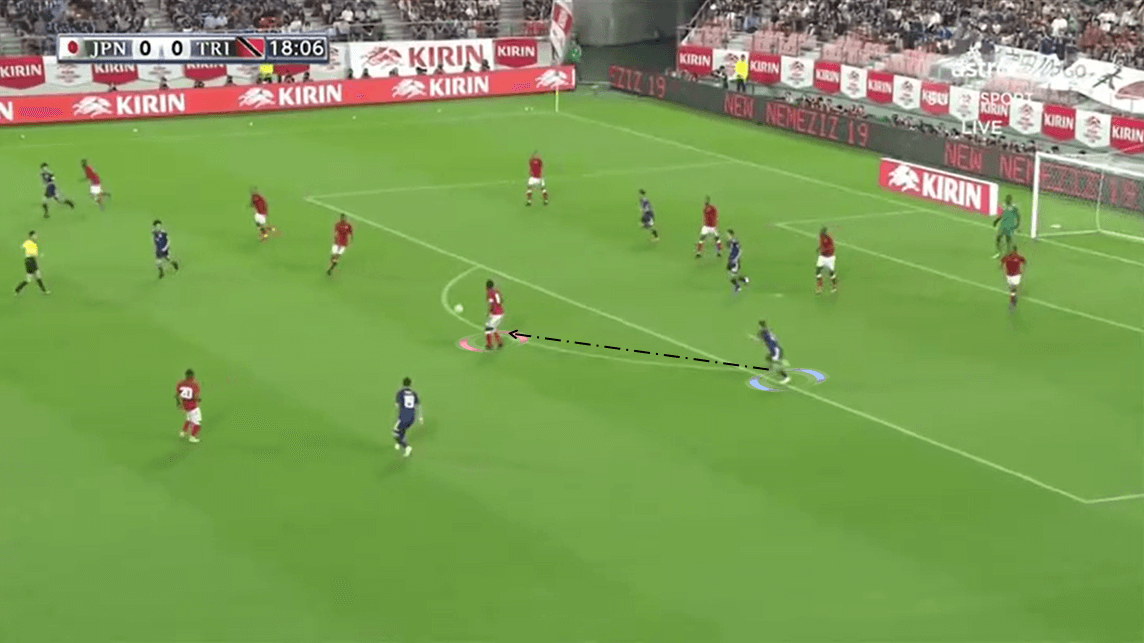
Conclusion
Replacing Hirving Lozano, a player who left a big influence on PSV’s tactics, immediately will be a very tough job. But the signing of Ritsu Dōan could prove to be a very interesting move for the club if the Japanese international continues to do what he does best.
On the ball, Dōan is a quick dribbler who has a quick mind to know where he wants to go. Using his technical abilities and the willingness to link up with his teammates, he helps the team progress the ball up the pitch and creates chances. As an attacking midfielder, his vision and passing skill allow Dōan to connect the midfielders with the striker up front. He makes progressive passes and through balls to put the teammate into a position where he can convert chances. Defensively, he is a very determined player to win the ball back. His pace gains him an advantage in reaching the ball carrier and with the heavy touches, he can accomplish what he intended to do.
The potential of PSV’s squad in general and the strikers specifically is so scary, as they can all become future stars either for the club or for a bigger name in Europe. Dōan comes into this group of players bringing another interesting option up front. He was good during his time with Groningen, playing a very important role in their journey of pushing for a Europa League spot. Now, at the Phillips Arena, the Japanese international will have his chance to prove himself at a higher level and potentially become the next player to make his name in the Eredivisie.
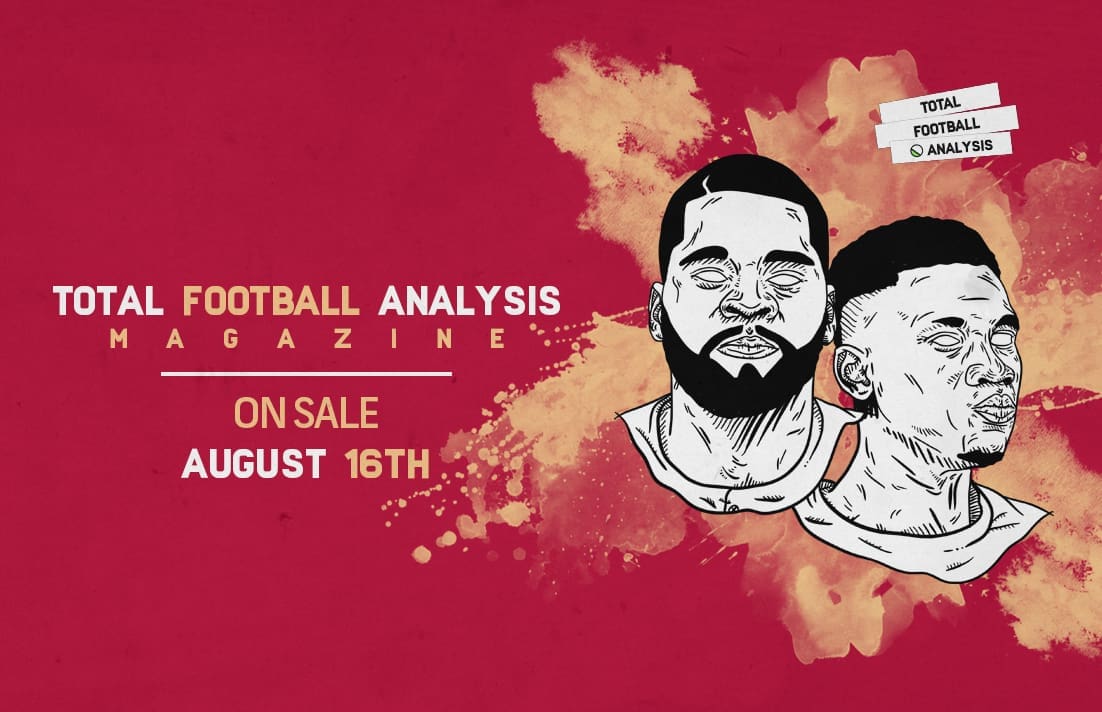
If you love tactical analysis, then you’ll love the digital magazines from totalfootballanalysis.com – a guaranteed 100+ pages of pure tactical analysis covering topics from the Premier League, Serie A, La Liga, Bundesliga and many, many more. Buy your copy of the August issue for just ₤4.99 here.

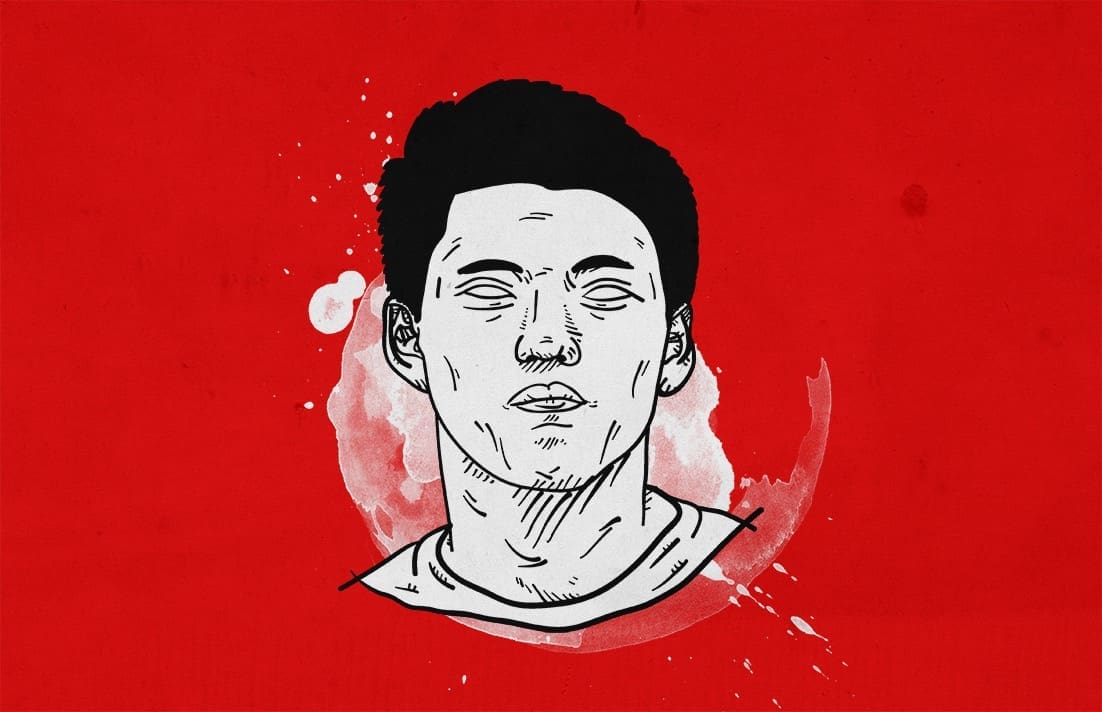



Comments